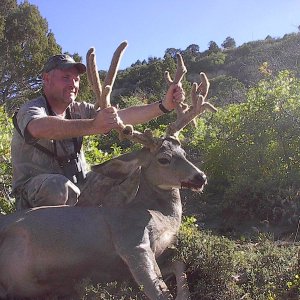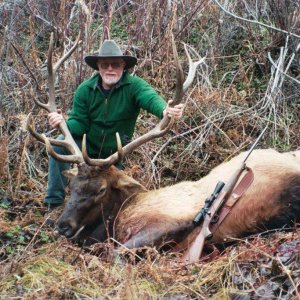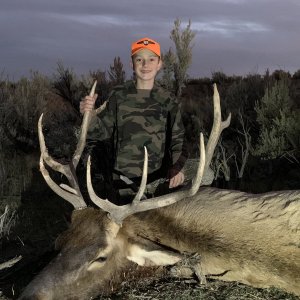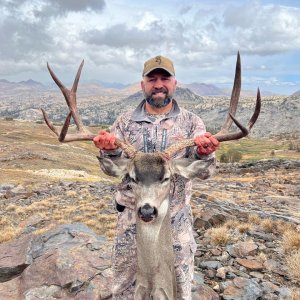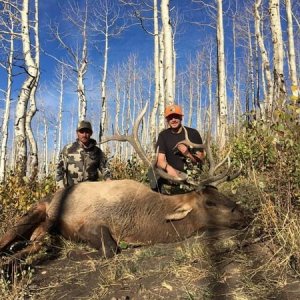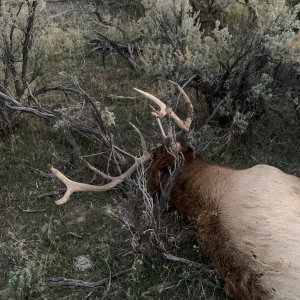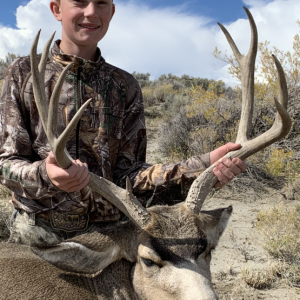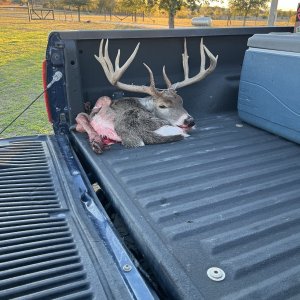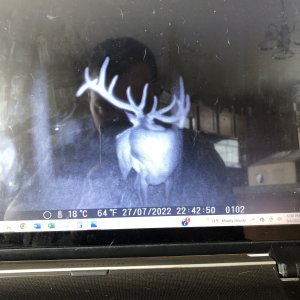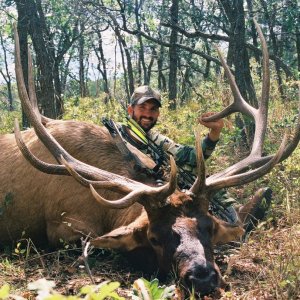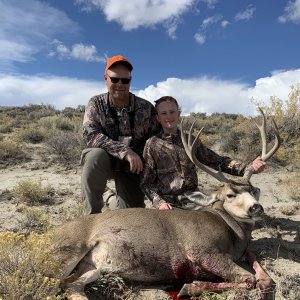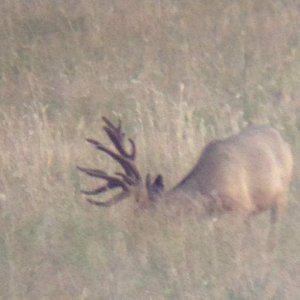You are using an out of date browser. It may not display this or other websites correctly.
You should upgrade or use an alternative browser.
You should upgrade or use an alternative browser.
Areas closed to hunting
- Thread starter buckhorn
- Start date
elkfromabove
Very Active Member
- Messages
- 2,098
>I see a lot of bucks
>in Zions NP and they
>look average.
The same for Bryce Canyon. The difference is the number of bucks you see, including mature bucks. There's more of them per 100 does, but antler growth requires the proper nutrition and genes of both sexes, as well as age, and closing a unit to buck hunting doesn't change those two things.
>in Zions NP and they
>look average.
The same for Bryce Canyon. The difference is the number of bucks you see, including mature bucks. There's more of them per 100 does, but antler growth requires the proper nutrition and genes of both sexes, as well as age, and closing a unit to buck hunting doesn't change those two things.
I'm not sure the average national park is large enough to have an effect, Yellowstone might be the exception. I'm pretty sure it is well documented that limited harvest of bucks = big bucks.
Closing down Henry mountain sure did get it done. Antelope Island too, for that matter. Large tracts of managed private property seem to work well too. The key is having smaller bucks that can grow up! Knock em all over as 2-points, and it's hard to get many big ones.
Closing down Henry mountain sure did get it done. Antelope Island too, for that matter. Large tracts of managed private property seem to work well too. The key is having smaller bucks that can grow up! Knock em all over as 2-points, and it's hard to get many big ones.
2lumpy
Long Time Member
- Messages
- 7,989
If hunting the area has left the area with very few bucks in the herd, most of the buck you will see during the next year will naturally be yearlings. If the area is then closed to hunting those yearlings that survive for another year will be "more mature" or one year older. The next year those bucks, that survive, will be still another year older, and so forth for as long as the area is closed to hunting. They'll get older until they either die of old age or something besides a hunter kills them. Depending on the other natural and man made environments in the area, most bucks will die of non-hunting causes before they reach what we would call "old age". On the mule deer studies in south central Utah, the average age of the does are 4.5 years. Most of the herd are younger deer so the quantity of younger deer shifts the average age lower, so there are a fair number of older does in the herd too, but not as many as yearling and two year old does. I don't know if the same would hold true for bucks, probably not due to the fight and stress of the rut put on bucks that doe aren't subjected to. It seems as though more bucks would die from non-hunting causes than does. More natural stress on the bucks.
On a study done on mule deer antler size, the average mature buck spread was 24". That's when the buck was maxed out. He'll begin to regress if he survives longer. Of course, that's average, some bucks mature with a 20" spread, others at 40", the average was 24".
Bottom-line: If your aren't killing them by hunting them, they'll get older and if the quality your inquiring about means antler size, then yes they'll get larger antlered as they get older, up to a point. Not every buck can grow a 190" set of antlers, (antler size is determined by the kind and time of his nutrition, his age and his genetic make up, and not always in that order. Not every buck gets the ideal feed at the right time of his life, lives to be 7 of 8 years of age, nor does he have perfect genetics, whether the area is closed to hunting or not.
Does that mean we should never close an area to hunting, to grow mule deer populations, or to allow some bucks to gain age or size, not in my opinion.
DC
On a study done on mule deer antler size, the average mature buck spread was 24". That's when the buck was maxed out. He'll begin to regress if he survives longer. Of course, that's average, some bucks mature with a 20" spread, others at 40", the average was 24".
Bottom-line: If your aren't killing them by hunting them, they'll get older and if the quality your inquiring about means antler size, then yes they'll get larger antlered as they get older, up to a point. Not every buck can grow a 190" set of antlers, (antler size is determined by the kind and time of his nutrition, his age and his genetic make up, and not always in that order. Not every buck gets the ideal feed at the right time of his life, lives to be 7 of 8 years of age, nor does he have perfect genetics, whether the area is closed to hunting or not.
Does that mean we should never close an area to hunting, to grow mule deer populations, or to allow some bucks to gain age or size, not in my opinion.
DC
fin little
Active Member
- Messages
- 762
The Paunsaugunt was closed to hunting for 7 years in the late 70's and early 80's. The genetics were there and alot of bucks reached maturity. You should have seen it.It looked just like you would think , Unreal. Also, I have seen some jaw dropping velvet bucks within Bryce Canyons Park boundries in recent years. Just not in the part the tourists swarm. In some National Parks( Bryce) the bucks migrate out and are hunted. Hunted bucks probably migrate into Zion.
txhunter58
Long Time Member
- Messages
- 8,529
Antelope island is essentially closed to hunting. Pretty good bucks there
txhunter58
venor, ergo sum (I hunt, therefore I am)
txhunter58
venor, ergo sum (I hunt, therefore I am)
nontypical
Long Time Member
- Messages
- 4,195
There is a national wildlife refuge north of Green River Wyoming on the Green River. 90% of the refuge is open to hunting. There is a small portion of the refuge where hunting is not allowed due to close proximity of the refuge headquarters and employee housing. Due to close proximity to Green River and Rock Springs, this deer unit gets extreme pressure( it's a general unit). You would be hard-pressed to find a mature buck over the age of 1&1/2 in this area. Few bucks live past being a yearling. But in the small area within the refuge that is closed to hunting, the difference in age and antler size is startling. 180-190 class bucks are seen laying about in the tall grass, chewing their cud like an old steer. I videoed a buck for many years in this area that exceeded 230 on his good years, and stayed over 200 on his bad years. These bucks know where they are safe and they stay there!
So the answer is "yes" to your question. Resoundingly.
So the answer is "yes" to your question. Resoundingly.
NECALI
Active Member
- Messages
- 717
I live about 30 miles from the Dixie Refuge in NE Ca.The bucks do have a better chance of getting older than the surrounding zones. They also hunt them in Nov. on a limited draw. Most of the big ones get shot there also. This is an answer to your question for those that don't know about it. But you probably knew this already
Dean
Dean
Elkhunter96
Very Active Member
- Messages
- 1,096
LAST EDITED ON Mar-26-14 AT 10:46AM (MST)[p]As others have said, Henry Mtns, Pauns and Antelope Island are all examples of closing a unit and letting the bucks mature for a while. Antelope island for almost a century if I remember right. Still, not every deer is going to get 190+ just like every guy isnt going to grow past 6 ft. Genes and food quality still play a huge part in it all.
travishunter3006
Very Active Member
- Messages
- 2,065
>I'm not in favor of it,
>too many people shoot first
>and count later IMO.
No they don't
>too many people shoot first
>and count later IMO.
No they don't
elkfromabove
Very Active Member
- Messages
- 2,098
>If hunting the area has left
>the area with very few
>bucks in the herd, most
>of the buck you will
>see during the next year
>will naturally be yearlings.
>If the area is then
>closed to hunting those yearlings
>that survive for another year
>will be "more mature" or
>one year older. The
>next year those bucks, that
>survive, will be still another
>year older, and so forth
>for as long as the
>area is closed to hunting.
> They'll get older until
>they either die of old
>age or something besides a
>hunter kills them. Depending
>on the other natural and
>man made environments in the
>area, most bucks will die
>of non-hunting causes before they
>reach what we would call
>"old age". On the
>mule deer studies in south
>central Utah, the average age
>of the does are 4.5
>years. Most of the
>herd are younger deer so
>the quantity of younger deer
>shifts the average age lower,
>so there are a fair
>number of older does in
>the herd too, but not
>as many as yearling and
>two year old does.
>I don't know if the
>same would hold true for
>bucks, probably not due to
>the fight and stress of
>the rut put on bucks
>that doe aren't subjected to.
> It seems as though
>more bucks would die from
>non-hunting causes than does.
>More natural stress on the
>bucks.
>
>On a study done on mule
>deer antler size, the average
>mature buck spread was 24".
> That's when the buck
>was maxed out. He'll
>begin to regress if he
>survives longer. Of course,
>that's average, some bucks mature
>with a 20" spread, others
>at 40", the average was
>24".
>
>Bottom-line: If your aren't killing them
>by hunting them, they'll get
>older and if the quality
>your inquiring about means antler
>size, then yes they'll get
>larger antlered as they get
>older, up to a point.
>Not every buck can grow
>a 190" set of antlers,
>(antler size is determined by
>the kind and time of
>his nutrition, his age
>and his genetic make up,
>and not always in that
>order. Not every buck
>gets the ideal feed at
>the right time of his
>life, lives to be 7
>of 8 years of age,
>nor does he have perfect
>genetics, whether the area is
>closed to hunting or not.
>
>
>Does that mean we should never
>close an area to hunting,
>to grow mule deer populations,
>or to allow some bucks
>to gain age or size,
>not in my opinion.
>
>DC
It depends on the area and the reason for closing it. Some areas are closed for reasons of safety (National Parks, some State Parks, etc.), or by law (Refuges, Military bases, etc.) or for reasons other than for growing huntable wildlife (private property, fire hazards, endangered species, etc.). But if the only reason for closing it is to grow the big game populations, then those closings should be far and few between because leaving the surplus bucks/bulls will not do that, especially in the long run.
However, if the closing is to increase the number (and size) of trophy bucks/bulls, then have at it, but ONLY on those units that are now designated as trophy units. Play with those units all you want to with closings, antler point restrictions, tag allotments, tag prices, auctions, higher buck to doe ratios or any other scheme you think will create the next world record, but leave the general hunt units to the 80% of us who have trophy hunting further down our list of priorities and manage those units for sustainable maximum opportunity! IMHO, of course.
>the area with very few
>bucks in the herd, most
>of the buck you will
>see during the next year
>will naturally be yearlings.
>If the area is then
>closed to hunting those yearlings
>that survive for another year
>will be "more mature" or
>one year older. The
>next year those bucks, that
>survive, will be still another
>year older, and so forth
>for as long as the
>area is closed to hunting.
> They'll get older until
>they either die of old
>age or something besides a
>hunter kills them. Depending
>on the other natural and
>man made environments in the
>area, most bucks will die
>of non-hunting causes before they
>reach what we would call
>"old age". On the
>mule deer studies in south
>central Utah, the average age
>of the does are 4.5
>years. Most of the
>herd are younger deer so
>the quantity of younger deer
>shifts the average age lower,
>so there are a fair
>number of older does in
>the herd too, but not
>as many as yearling and
>two year old does.
>I don't know if the
>same would hold true for
>bucks, probably not due to
>the fight and stress of
>the rut put on bucks
>that doe aren't subjected to.
> It seems as though
>more bucks would die from
>non-hunting causes than does.
>More natural stress on the
>bucks.
>
>On a study done on mule
>deer antler size, the average
>mature buck spread was 24".
> That's when the buck
>was maxed out. He'll
>begin to regress if he
>survives longer. Of course,
>that's average, some bucks mature
>with a 20" spread, others
>at 40", the average was
>24".
>
>Bottom-line: If your aren't killing them
>by hunting them, they'll get
>older and if the quality
>your inquiring about means antler
>size, then yes they'll get
>larger antlered as they get
>older, up to a point.
>Not every buck can grow
>a 190" set of antlers,
>(antler size is determined by
>the kind and time of
>his nutrition, his age
>and his genetic make up,
>and not always in that
>order. Not every buck
>gets the ideal feed at
>the right time of his
>life, lives to be 7
>of 8 years of age,
>nor does he have perfect
>genetics, whether the area is
>closed to hunting or not.
>
>
>Does that mean we should never
>close an area to hunting,
>to grow mule deer populations,
>or to allow some bucks
>to gain age or size,
>not in my opinion.
>
>DC
It depends on the area and the reason for closing it. Some areas are closed for reasons of safety (National Parks, some State Parks, etc.), or by law (Refuges, Military bases, etc.) or for reasons other than for growing huntable wildlife (private property, fire hazards, endangered species, etc.). But if the only reason for closing it is to grow the big game populations, then those closings should be far and few between because leaving the surplus bucks/bulls will not do that, especially in the long run.
However, if the closing is to increase the number (and size) of trophy bucks/bulls, then have at it, but ONLY on those units that are now designated as trophy units. Play with those units all you want to with closings, antler point restrictions, tag allotments, tag prices, auctions, higher buck to doe ratios or any other scheme you think will create the next world record, but leave the general hunt units to the 80% of us who have trophy hunting further down our list of priorities and manage those units for sustainable maximum opportunity! IMHO, of course.
buckhorn
Very Active Member
- Messages
- 2,665
The hunts in Idaho I'm referring to are 73,40,42.
73 was restricted to 2 pt. only for a number of years.(cant remember how many).They grew quickly and there got to be a surplus of BIG bucks. When they finally opened it back to an any buck season it was for 5 days. The mistake IDFG made was that the 5 days for the any buck season was at the end of Oct. And the rut was kicking in. Also the tags were unlimited. It only took 2 seasons to kill off most of the bucks. After that they tried doing the 5 days starting on Oct. 10. By then it was too late, the damage was done. Will 73 ever bounce back?
In 40 and 42 they still have the 2 pt. only general season in Oct. and the any buck hunts are in Nov. with limited tags. I'v hunted the "Owyhees" 3 times in the last 10 years (twice for myself and once with a friend)and the number of mature bucks seems to be declining. What could be done to turn this around?
buckhorn
73 was restricted to 2 pt. only for a number of years.(cant remember how many).They grew quickly and there got to be a surplus of BIG bucks. When they finally opened it back to an any buck season it was for 5 days. The mistake IDFG made was that the 5 days for the any buck season was at the end of Oct. And the rut was kicking in. Also the tags were unlimited. It only took 2 seasons to kill off most of the bucks. After that they tried doing the 5 days starting on Oct. 10. By then it was too late, the damage was done. Will 73 ever bounce back?
In 40 and 42 they still have the 2 pt. only general season in Oct. and the any buck hunts are in Nov. with limited tags. I'v hunted the "Owyhees" 3 times in the last 10 years (twice for myself and once with a friend)and the number of mature bucks seems to be declining. What could be done to turn this around?
buckhorn
Buckhorn,
RE: Unit 73. After the 2-point only, they went to 4-point minimum restriction - 7 day hunt opening Oct 10. This resulted in LOTS of nice bucks. My only criticism of that strategy was that it put a lot of pressure on the big bucks. A lot of kids and meat hunters that would be happy with a forky were forced to hold out for a 4-pointer. Then one day there were a few big 3-point's running around (which really pisses people off!) so they had to do away with that, and went to the Unlimited Controlled hunt strategy. Now there are not as many bucks, not as many big bucks, and way too many hunters in 73.
RE: Unit 73. After the 2-point only, they went to 4-point minimum restriction - 7 day hunt opening Oct 10. This resulted in LOTS of nice bucks. My only criticism of that strategy was that it put a lot of pressure on the big bucks. A lot of kids and meat hunters that would be happy with a forky were forced to hold out for a 4-pointer. Then one day there were a few big 3-point's running around (which really pisses people off!) so they had to do away with that, and went to the Unlimited Controlled hunt strategy. Now there are not as many bucks, not as many big bucks, and way too many hunters in 73.
buckhorn
Very Active Member
- Messages
- 2,665
>Buckhorn,
>
>RE: Unit 73. After the 2-point
>only, they went to 4-point
>minimum restriction - 7 day
>hunt opening Oct 10. This
>resulted in LOTS of nice
>bucks. My only criticism of
>that strategy was that it
>put a lot of pressure
>on the big bucks. A
>lot of kids and meat
>hunters that would be happy
>with a forky were forced
>to hold out for a
>4-pointer. Then one day there
>were a few big 3-point's
>running around (which really pisses
>people off!) so they had
>to do away with that,
>and went to the Unlimited
>Controlled hunt strategy. Now there
>are not as many bucks,
>not as many big bucks,
>and way too many hunters
>in 73.
UGAhunter, I totally agree.
I lived in Marsh Valley near Robin for 8 years.
buckhorn
>
>RE: Unit 73. After the 2-point
>only, they went to 4-point
>minimum restriction - 7 day
>hunt opening Oct 10. This
>resulted in LOTS of nice
>bucks. My only criticism of
>that strategy was that it
>put a lot of pressure
>on the big bucks. A
>lot of kids and meat
>hunters that would be happy
>with a forky were forced
>to hold out for a
>4-pointer. Then one day there
>were a few big 3-point's
>running around (which really pisses
>people off!) so they had
>to do away with that,
>and went to the Unlimited
>Controlled hunt strategy. Now there
>are not as many bucks,
>not as many big bucks,
>and way too many hunters
>in 73.
UGAhunter, I totally agree.
I lived in Marsh Valley near Robin for 8 years.
buckhorn
Gator
Long Time Member
- Messages
- 18,131
For every great in-town buck there are others that live there and don't get as big, So My guess is genetic has to be a huge factor in that end of it.
Age and Genetic has to be the most important factor in growing Big buck.
"I have found if you go the extra mile it's Never crowded".
>[Font][Font color = "green"]Life member of
>the MM green signature club.[font/]
Age and Genetic has to be the most important factor in growing Big buck.
"I have found if you go the extra mile it's Never crowded".
>[Font][Font color = "green"]Life member of
>the MM green signature club.[font/]
Similar threads
- Replies
- 4
- Views
- 1k

